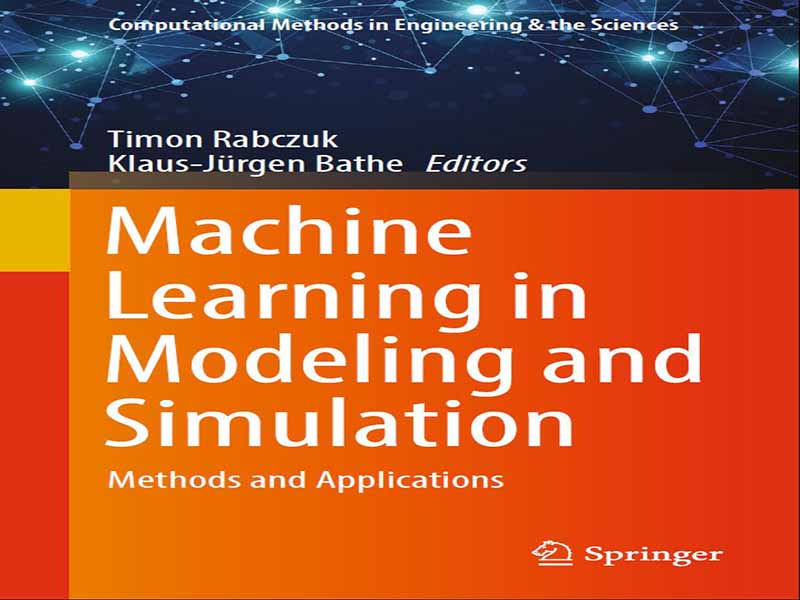- عنوان کتاب: Machine Learning in Modeling and Simulation
- نویسنده: Timon Rabczuk
- حوزه: یادگیری ماشین
- سال انتشار: 2023
- تعداد صفحه: 456
- زبان اصلی: انگلیسی
- نوع فایل: pdf
- حجم فایل: 12.7 مگابایت
تکنیک های یادگیری ماشینی (ML) اخیراً به طور قابل توجهی موفق شده اند. اگرچه برخی از اصول اولیه چندین دهه پیش ایجاد شد، ظهور تجزیه و تحلیل عددی و محاسبات موازی مجهز به GPU، همراه با برخی پیشرفتهای نظری اخیر، منجر به پیشرفت قابل توجهی در ML در زمینههای مختلف، مانند تشخیص تصویر و گفتار، پردازش زبان طبیعی شده است. ، بیوانفورماتیک و نظریه بازی ها. بسیاری از برنامه های کاربردی توسعه یافته نیاز به مقادیر زیادی داده برای استفاده به عنوان مجموعه آموزشی دارند. با این حال، همچنین، پیشرفتهای فوقالعادهای در داشتن الگوریتم رایانهای حاصل شده است که راهحل مسئله را از مقدار معقول داده و مجموعهای ساده از قوانین یاد میگیرد.
در حالی که رویکردهای ML در تعدادی از زمینهها مانند اقتصاد، تجارت الکترونیک، تشخیص تصویر، تفسیر زبان و پزشکی استفاده شدهاند، پتانسیل کامل آنها در “مدلسازی و شبیهسازی” هنوز نیاز به بررسی دارد. در واقع، رویکردهای ML این پتانسیل را دارند که هزینههای محاسباتی را به شدت کاهش دهند – از طراحی گرفته تا تحلیل و طراحی – و اجازه میدهند مشکلات چالش برانگیزی در مهندسی و علوم محاسباتی حل شوند که قبلاً هرگز حل نشدهاند، در واقع حتی قبلاً نیز حل نشدهاند.
الگوریتم های یادگیری ماشینی را می توان به دو دسته اصلی تقسیم کرد: یادگیری تحت نظارت و بدون نظارت. در هر دو کلاس، الگوریتمها به مجموعهای از مشاهدات برای نقش دادههای آموزشی دسترسی دارند. با این حال، ماهیت داده های آموزشی، و در نتیجه آنچه می توان از آنها استخراج کرد، متفاوت است. در یادگیری نظارت شده، داده های آموزشی شامل مجموعه ای معین از مقادیر ورودی و مجموعه ای متناظر از مقادیر خروجی است. با استفاده از دادههای آموزشی، الگوریتم ML سعی میکند بهترین پارامترهای یک تابع پیشبینی را بیابد که بتواند خروجی را بهعنوان تابعی از ورودی، هر کدام مورد علاقه، به دقت شبیهسازی کند. از سوی دیگر، در یادگیری بدون نظارت، خروجی مورد علاقه از قبل مشخص نیست و استفاده موثر از داده ها بسیار چالش برانگیزتر است. کلاس متوسط سوم وجود دارد، یادگیری نیمه نظارتی. در این مورد، برخی، اما نه همه مقادیر ورودی داده شده، مقادیر خروجی مربوطه را داده اند.
Machine learning (ML) techniques have recently become remarkably successful. Although some of the basic principles were established decades ago, the advent of GPU-enabled numerical analysis and parallel computing, coupled with some recent theoretical advances, has led to significant ML progress in diverse fields, such as image and speech recognition, natural language processing, bioinformatics, and game theory. Many of the developed applications require large amounts of data to be used as training sets. However, also, tremendous advances have been made in having a computer algorithm learn the problem solution from a reasonable amount of data and a simple set of rules.
While ML approaches have been applied in a number of areas such as economics, e-commerce, image recognition, language interpretation, and medicine, their full potential in “Modeling and Simulation” still needs to be explored. Indeed, ML approaches have the potential to drastically reduce the computational cost—from design to analysis back to design—and allow challenging problems in engineering and the computational sciences to be solved which have never been solved before, in fact not even been tackled before.
Machine learning algorithms can be separated into two main classes: supervised and unsupervised learning. In both classes, the algorithms have access to a set of observations for the role of training data. However, the nature of the training data, and hence what can be extracted from them, differs. In supervised learning, the training data consists of a given set of input values and a given corresponding set of output values. Using the training data, the ML algorithm tries to find the best parameters of a prediction function that can accurately emulate the output as a function of the input, each of interest. On the other hand, in unsupervised learning the output of interest is not known a priori and an effective use of the data is much more challenging. The third intermediate class exists, semi-supervised learning; in this case, some, but not all of the given input values have given corresponding output values.
این کتاب را میتوانید از لینک زیر بصورت رایگان دانلود کنید:




































نظرات کاربران